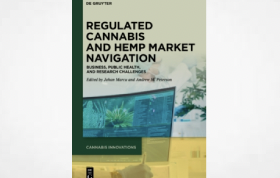Thanks to Lex Pelger for highlighting
Introduction
Various countries and US States have legalized cannabis, and the use of the psychoactive1 and non-psychoactive cannabinoids is steadily increasing. In this review, we have collated evidence from published non-clinical and clinical sources to evaluate the abuse, dependence and associated safety risks of the individual cannabinoids present in cannabis. As context, we also evaluated various synthetic cannabinoids. The evidence shows that delta-9 tetrahydrocannabinol (Δ9-THC) and other psychoactive cannabinoids in cannabis have moderate reinforcing effects. Although they rapidly induce pharmacological tolerance, the withdrawal syndrome produced by the psychoactive cannabinoids in cannabis is of moderate severity and lasts from 2 to 6 days. The evidence overwhelmingly shows that non-psychoactive cannabinoids do not produce intoxicating, cognitive or rewarding properties in humans. There has been much speculation whether cannabidiol (CBD) influences the psychoactive and potentially harmful effects of Δ9-THC. Although most non-clinical and clinical investigations have shown that CBD does not attenuate the CNS effects of Δ9-THC or synthetic psychoactive cannabinoids, there is sufficient uncertainty to warrant further research. Based on the analysis, our assessment is cannabis has moderate levels of abuse and dependence risk. While the risks and harms are substantially lower than those posed by many illegal and legal substances of abuse, including tobacco and alcohol, they are far from negligible. In contrast, potent synthetic cannabinoid (CB1/CB2) receptor agonists are more reinforcing and highly intoxicating and pose a substantial risk for abuse and harm. 1 “Psychoactive” is defined as a substance that when taken or administered affects mental processes, e.g., perception, consciousness, cognition or mood and emotions.
Introduction
The psychoactive (definition: exerting effects on mental processes, e.g. perception, consciousness, cognition or mood and emotions) and medicinal properties of the cannabis plant species, Cannabis sativa and Cannabis indica, have been known for thousands of years. The first written reports of their medical and recreational use were in Asia, occurring in the third millennium B.C. and evidence exists to suggest that the first human use of these plants dates as far back as the Neolithic period several thousand years earlier.
Cannabis plants produce more than 400 chemical compounds and approximately 60 of them are biologically active. The two best known plant-derived cannabinoids (phytocannabinoids) are Δ9-tetrahydrocannabinol (Δ9-THC), which is the predominant psychoactive molecule present in cannabis, and cannabidiol (CBD) which is non-psychoactive. These compounds together with a range of other plant-derived and synthetic cannabinoids that are discussed in this review are shown in Figure 1.
















